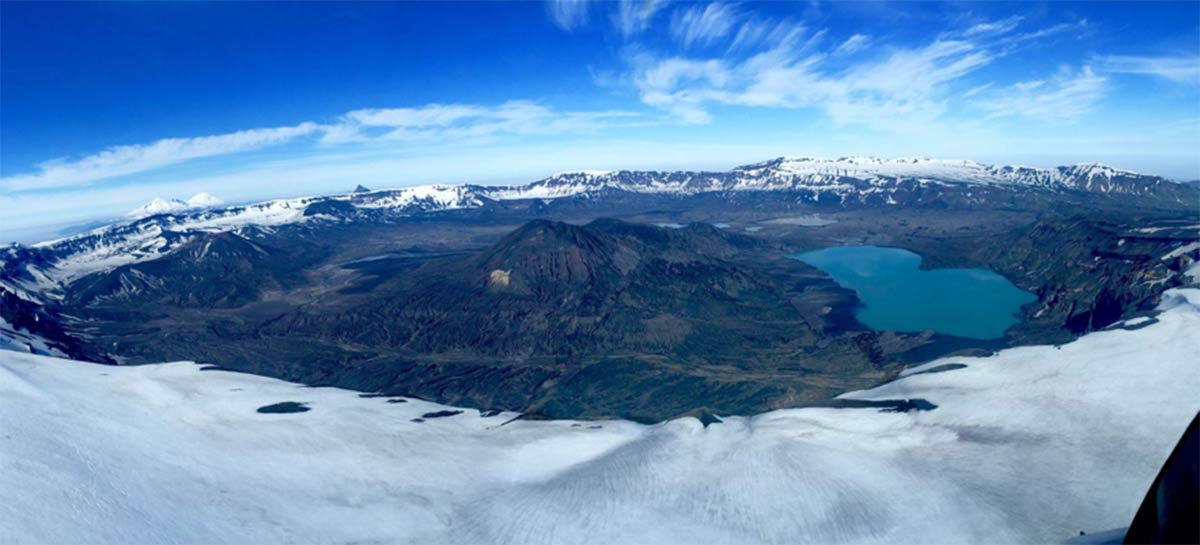Discovered: The Highland Volcano That Collapsed Ancient Rome
Following Julius Caesar ’s assassination in 44 BC extreme climate change led to crop failures which in turn fueled the increasing social unrest in Rome, adding greatly to the social disruption caused by the civil war, that bought the Republic to an Empire. The string of events caused the collapse of the Roman Republic. But now, a recent study suggests the cause of the climate change was a volcanic eruption of Mt. Okmok, over 9,000km (6,000 miles) away in Alaska.
Tracking The Civilization Eating Fire-Dragon
A new paper published in PNAS by environmental researcher Joe McConnell of the Desert Research Institute, which is affiliated with the University of Nevada, Reno, explains how ancient Roman writers described short growing seasons cause by cold weather, resulting in crop failures and famine in northern Italy and northern Greece between April 43 BC through 36 BC, in what was already a turbulent time.

The Death of Caesar by Vincenzo Camuccini – assassination at the beginning of the collapse of Rome. (Public Domain)
Erupting volcanoes eject sulfur dioxide high into the Earth’s stratosphere where it reflects solar radiation, blocks the Sun ’s light, and sharply decreases the temperature on continents sometimes a long way away from the epicenter of the eruption. Scientists have never been quite sure which volcano caused the natural disasters in Rome, until now.
One Of The Greatest Ejections In History
Just before Caesar’s death in 44 BC, Mt. Etna exploded, and it is known that this caused some of the climate changes described by writers in that year, but the new study of Greenland ice cores, from north-central Greenland, found volcanic ash and sulfuric acid in the ice layers of snow that had been laid down in the early winter of 43 BC, and for the next two years, which suggested the historic blast came from Mt. Okmok, in modern day Alaska.
Dr. McConnell told ARS Technica that his team “found the Okmok II sulfur fallout in every Arctic ice core record that we had access to, including five from all over Greenland and one from Akademii Nauk in the Russian Arctic.” Furthermore, the “geochemistry” of the frozen sulphur infused ash matched layers of tephra (rock fragments) associated with an ancient eruption of Mt. Okmok II which the researchers say was “one of the largest eruptions of the last few thousand years,” and that the results of this ejection are comparable to Mt. Pinatubo in 1991, Krakatoa in 1883, or Tambora in 1815.

Detailed records of past explosive volcanic eruptions are archived in the Greenland ice sheet and accessed through deep-drilling operations. (Image: Dorthe Dahl-Jensen / DRI)
Analyzing Geochemical Fingerprints
Testing their suspicions, Connell and his colleagues created computer simulations of the Okmok II eruption and their models predicted summer temperatures in the years after the eruption would be “2⁰C to 3⁰C cooler than usual across most of the Northern Hemisphere,” and this matched the observed climatology descried by the ancient writers. McConnell told Ars Technica that “Geochemically fingerprinting” the ash samples was the key to identifying the volcanic source, and that this knowledge underpinned their detailed climate modeling.
The Okmok II eruption lasted from 43 BC to 41 BC, while the Roman Republic was already rotten at its core with the violent power struggles following Julius Caesar ’s death, and the paper explains that “Natural disasters are known historically to create a ‘state of exception “in which business as usual becomes unfeasible, and political and cultural norms are suspended, thereby providing room for rapid social and political change,” wrote McConnell.
- Chaluka: A Site so Remote, The Ancient Aleutians of Alaska Lived in Peace for Millennia
- 12,300-Year-Old Bone Pendants May be Oldest Artwork Ever Discovered in Alaska
- Volcanic Eruptions and Climate Change Incited Upheaval in Ancient Egypt - and Historians Warn of Repetition
Okmok II, Tried And Convicted
Survival in Ancient Egypt depended greatly on the Nile ’s summer floods fertilizing the fields along its banks, while Mediterranean coastal farmers most often dealt with too much rain, and the ancient writers say that in 43 and 42 BC the floods didn ’t come but that a terrible famine occurred in those years. And the reason for this, according to the new paper, is because Mt. Okmok II “cooled the Northern Hemisphere, short-circuiting the weather systems that produce the Nile’s annual flood.”
McConnell explained that “differential cooling” shifts equatorial rain belts north or south,” and when eruptions occur in high northern latitudes, like at Okmok II 43 BC, failures in East African Summer Monsoons result in “drought in the headwaters of the Nile and so a failure in the all-important summer flood.” Thus, McConnell and his team have successfully analyzed ancient ice samples gathered on another continent to illustrate the events leading up to the collapse of ancient Rome.
Top image: The 10km-wide caldera on Alaska's Unmak Island formed during the 43 BC Okmok II eruption that contributed to the collapse of Rome. Source: Kerry Key (Columbia University, New York, NY/ Desert Research Institute
By Ashley Cowie



















